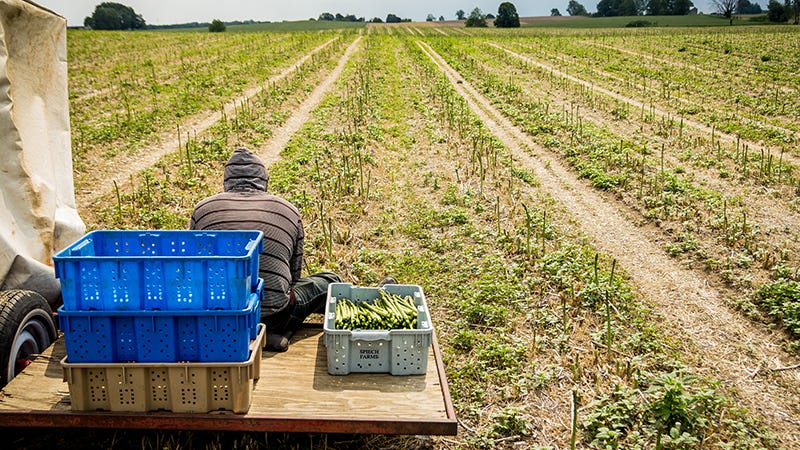Nov 28, 2023
Growers decry more expensive ag labor
Growers are bracing to pay more – around 7% – for their crews in the coming year.
The Adverse Effect Wage Rate (AEWR) for the H-2A program is expected to rise, based on the results of USDA’s Farm Labor Report. The Nov. 22 report shows the number of October hired workers declined 1%, but the gross wage rate increased 6% from the previous year.
For the 10th consecutive year, Michigan farmers using the H-2A program in 2024 will likely be required to pay workers more under the AEWR. Assuming the Department of Labor (DOL) follows its normal procedure for calculating AEWR, Michigan growers utilizing H-2A workers in 2024 would pay $18.50 per hour, an increase of $1.16 — or 6.7% — from the current rate of $17.34.

That’s the fourth highest in the nation behind California’s $19.75, the Pacific Region’s $19.25 and Hawaii’s $18.74, according to a news release from the Michigan Farm Bureau.
As part of the Southeast region that encompasses Georgia, Alabama and South Carolina, Georgia anticipates a 7% rise in its AEWR, climbing to $14.66 from $13.67. This increase follows a 14% rise in 2022. Notably, only Hawaii is projected to experience a higher percentage increase compared to Georgia, South Carolina and Alabama.
Over the past two years, Georgia has observed a significant 22% escalation in AEWR, soaring from $11.99 to the current $14.66. Georgia’s AEWR now stands at twice the state’s minimum wage. It is important to note that these rates are subject to change pending the official posting in the Federal Register by the Department of Labor, according to a news release from the Georgia Fruit and Vegetable Growers Association (GFVGA).
While DOL will announce the official AEWR for each state in late December, AEWR is typically identical to USDA’s reported annual weighted average hourly wage rates for field and livestock workers combined, Michigan Farm Bureau said in the release.
“The rule now triggers an AEWR adjustment twice a year,” according to a release from the Florida Fruit & Vegetable Association. “Employers should be mindful that FLS-based wages will update in January, and OEWS-based wages will update in July.”
“This isn’t just a food-security issue,” Michael DeRuiter, an Oceana County Michigan fruit grower and vice president of Michigan Farm Bureau (MFB), told Rep. Elissa Slotkin at a November roundtable. “It’s a national security issue. Labor is the big thing right now that could put us all out quickly. We’re just hanging on right now; there’s no stability. I guess Happy Thanksgiving to us.”
Things are so bad in the specialty crop world that Hart, Michigan, grower Sarah Greiner had a betting pool with her workforce on what the increase could be.
“We’ve been telling this story about labor for a long time,” Greiner told Slotkin. “Something’s got to be done. It’s got to be looked at, and we’re running out of time.”
![]() Economists say that the wage rate could approach $25 to $30 in the next 10 years if reform isn’t done. Already, growers are switching to different economies — corn or soybeans — because of the wage increases.
Economists say that the wage rate could approach $25 to $30 in the next 10 years if reform isn’t done. Already, growers are switching to different economies — corn or soybeans — because of the wage increases.
On Nov. 27, MFB will ask members to join them in asking Congress to put a one-year freeze on AEWR by sending pre-written messages to elected officials.
“We’re on an unsustainable path with AEWR, and it’s quickly become an issue that only Congress has the power to address,” John Kran, MFB national legislative counsel, said in the release.
“Losing fruit and vegetable growers in the U.S. puts our country at risk by becoming dependent on foreign products. That’s why we’re calling on lawmakers to step up and help farmers navigate this difficult situation — before it’s too late.”
According to American Farm Bureau Federation data, labor accounts for nearly 40% of total production costs on some farms. Slotkin recently told Michigan Farm News she will be contacting the Department of Labor and stress farmers’ concerns.
At $18.50, the AEWR would more than $11.25 higher than the current federal minimum wage and more than 83% higher than the Michigan minimum wage of $10.10.
“This unwelcome news is made worse by new data from the U.S. Department of Agriculture demonstrating that imports of vegetables from Mexico have continued to grow in 2023, surging 14% over the same period last year,” GFVGA said in the release. “Cabbage, cucumber, tomato, beans, peas, and carrots all showed double-digit growth in foreign imports with strawberries and other berries also up considerably.”
Slotkin’s cosponsored bill, HR 3308, freezes the minimum wage for H-2A workers.
“AEWR increases affect all farms in Michigan, not just those who employ H-2A labor, as it artificially inflates the wages in the corresponding areas,” Sarah Black, manager of Great Lakes Ag Labor Services, which provides administrative support services for Michigan farmers using H-2A workers, said in the release.






